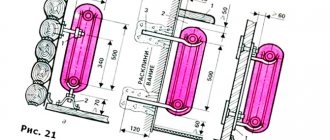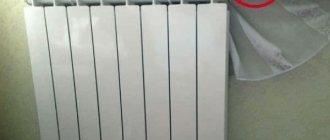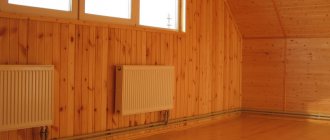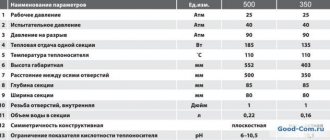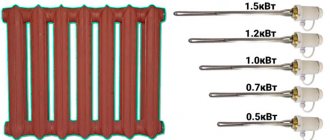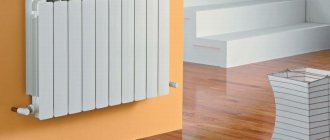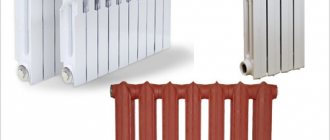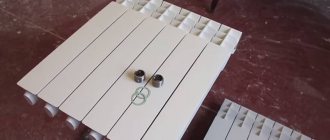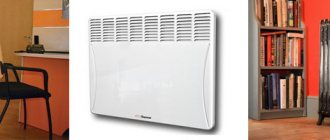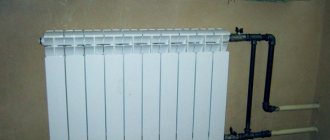Threaded bracket.
A bracket for radiators is a specific fastening element that allows you to fix the heating element in the right place and in the right position. In this case, the position of the radiator should not change over time and under the influence of increased operating loads. Today you can find both specialized fasteners, for example, a bracket for a cast iron radiator, and a unified device.
The latter, according to manufacturers, allows you to correctly and firmly fix any type of heating device. In practice, experts still recommend buying devices that take into account the characteristics of each specific battery model and their construction material.
Choosing a bracket for a cast iron radiator
Adjustable floor bracket K 11.3.
The bracket for a cast iron radiator must be of increased strength and size. The design of the fastening element is influenced by the parameters of the heating element itself. Cast iron batteries (Konner and STI Nova) are heavy and massive among all types of radiators.
To fix cast iron heating devices, the following types of clamps are used:
- cast, cast iron;
- steel pins 300 mm long with dowel;
- steel with stripes;
- steel with the ability to adjust the horizontal position and distance from the wall.
The choice of fastener is also influenced by the structural material of the wall. So, for a brick and concrete wall, a pin fastening is suitable. Devices with up to 10 sections are mounted on the wall using two brackets at the top and one at the bottom. A heating device with more than 10 sections in size requires additional support using floor clamps and stands. For installation on soft wall materials (plasterboard and wood), only floor fasteners are suitable. It can have a height adjuster or be produced without it.
The bracket for a cast iron battery must be reinforced. This is evidenced by the corresponding inscription on the packaging with the mount - “reinforced”.
Replacing heating radiators in an apartment
Art. 25 Housing Code of the Russian Federation, Russian Federation No. 37 dated 08/04/1998, Central heating radiators
Consequently, moving or replacing heating devices, as well as changing their configuration, does not require changes in the technical passport, and also cannot be considered as a refurbishment of the premises, and, as a result, is a violation of the procedure for using common property.
Coordination
The apartment owner first needs to agree on:
- replacing the original radiators with similar radiators;
- replacing batteries with radiators of a different type, with possible configuration changes;
- transfer of batteries.
In the first case of replacing batteries with similar radiators, it will only be enough to notify the management organization about the upcoming installation.
Subsequently, you need to seek the help of a specialist who will determine the possibility of installing new devices. The examination is paid for by the owner of the apartment.
To select and replace heating devices in your apartment, you need to understand the main stages of work, as well as possible problems that you may encounter during the work process.
Material selection
Bimetallic batteries with a steel core and aluminum fins have 4 important properties:
- high mechanical strength, thanks to the high level - 16 atmospheres - operating pressure and test pressure - up to 30 atmospheres;
- the chemical stability of the core has the ability to form a galvanic couple with copper pipelines;
- high efficiency;
- the modern look is quite presentable.
Cast iron radiators are corrosion resistant
Steel radiators can be sectional or panel. Sectional radiators in appearance resemble cast iron batteries. Steel radiators are able to withstand a working pressure of 16 atmospheres and also have a long service life. The main disadvantage is the risk of damage due to water hammer or external mechanical impact, due to the relatively thin steel - 1.5 mm.
Aluminum radiators are lightweight, so battery installation can be done by one person. The positive qualities of radiators lie in the large number of product options that differ in functionality and form, as well as an immediate response to changes in water temperature. Disadvantages include the need for air removal and unacceptable contact of the coolant with other metals. If this rule is not followed, the radiator may be destroyed by chemical attack.
Calculating the number of sections
To calculate the required number of sections, you can use a simple algorithm: 2 sq. m. area = 1 section
In addition to the throttle or thermostatic head, it is advisable to install the following near each radiator:
- an additional valve on the second line of the supply line, which will completely cut off the radiator and allow, if necessary, to completely disconnect and dismantle the radiator;
- a valve on the jumper, which in the closed position will direct the entire flow of water in the riser through the radiator, otherwise through the bypass.
Fixing bimetallic radiators
Floor plastic bracket for bimetallic batteries.
Brackets for bimetallic radiators are selected based on the dimensions of the equipment, the number of sections, installation options and features of the structural material of the walls. Compared to cast iron batteries, bimetallic counterparts weigh much less. This type can be mounted directly on a wall (brick or concrete) using universal brackets with dowels. For a plasterboard base, a floor option with adjustable and non-adjustable height (center distance 200, 350, 500) is more suitable.
If the room has a panoramic window and bimetallic radiators (Rifar, Sira, Global) are selected to heat the room, then they can be fixed in the desired position using either floor fasteners or a steel corner product. Brackets for bimetallic radiators must be made of steel.
Basic requirements for room insulation
Few people think about why heating radiators are most often installed under windows, and people would be even more surprised to learn that a deviation of 2-3 centimeters can affect the efficiency of their operation. Sometimes heat loss is 20% only because the heater installation parameters were not followed.
Bimetallic radiators today are not only the most expensive on the thermal technology market, but also the most durable, reliable and durable. Therefore, it will be doubly disappointing to invest a lot of money on their purchase and connection and end up with a cold room, the heating of which takes a lot of energy resources.
Since, according to their parameters, bimetallic batteries are ideal for a “not ideal” urban heating network, their positive qualities should be used to the maximum.
Before installing bimetallic heating radiators, heat loss should be minimized:
- Up to 50% of heat escapes through uninsulated walls.
- Windows “eat up” 20%.
- An unheated basement or attic adds 10% of heat loss.
If you do not carry out preliminary work to insulate the room, then even the best-quality heating radiators will not be able to withstand such losses, or the costs of heating it will be too high.
Not all consumers know that simply installing a foil screen behind the radiator will reduce heat loss by 30% . If it is not possible to fully insulate external walls, it is enough to make such a reflector to reduce damage.
Having carried out a complete “audit” of heat losses and eliminated at least some of them, you can begin to calculate how many sections will be required for the room, and where the installation of bimetallic radiators will be carried out.
Fixing the steel heater
Adjustable floor bracket K 11.9.
Although steel heating equipment is heavy, it is not as massive compared to cast iron counterparts. That is why the bracket for steel radiators (Korado) can have a welded structure. A U-shaped and K-shaped element made of steel is suitable here. It is attached to the wall and is used if the panel heater is equipped with special brackets.
In front of the panoramic window, a bracket for floor-mounted steel radiators would be relevant. But in this case it must have a reinforced structure. If the heating device is large in size, then additional fixation is used for its installation using an angle bracket. Two types of fasteners: wall (rod with dowel or steel with plate) and floor, adjustable stand are useful when the structural material of the wall is not durable. This could be wood or porous bricks.
How efficient should the heating of a frame house be and how the degree of insulation affects the efficiency of the heating circuit.
Read about what types of water heating schemes there are for a one-story house here.
How to hang a battery
The instructions themselves are extremely simple, in principle I have already talked about it - you drill a hole in the wall with a hammer drill and screw the bracket. But there are nuances associated with preparation.
Modern canopies with intermediate fixation of the radiator.
So, if you are installing a radiator in a multi-storey building with central heating, then before installation you will need to invite mechanics from the local housing office. They will turn off the riser and drain the water from it.
Strange as it may sound, it is better to change batteries during the heating season. In this case, you will immediately see flaws in your work and will be able to quickly eliminate them. And if you install the battery in the summer, then when the water is turned on and the house is put under pressure, any mistake during installation can turn into a rush and it is not a fact that someone will be at home at that time.
Any radiator is installed strictly according to level.
Now a few words about how to mark the mounts for radiators:
- The first plumb line is the central center line;
- Next, perpendicular to the axial one, you need to draw a horizontal line on which the upper brackets will be mounted;
- If you have only 1 bracket from below, then it is mounted on a vertical axial;
- If there are several bottom brackets, then the same horizontal line is drawn below as on top and the installation points of the canopies are marked on it.
Marking option for installing a radiator.
Aluminum batteries and their fastening
Bracket for lightweight aluminum radiator.
This type of heating elements is the lightest. However, at the same time, its structural material has a high coefficient of thermal expansion. These parameters must be taken into account when choosing a bracket for an aluminum radiator.
Pay attention to the following types of fasteners:
- steel corner. Depending on the size of the heating equipment, it can have a simple or reinforced design;
- round or flat pin with dowel for batteries with different center distances;
- universal with plastic cover;
- floor adjustable fasteners.
In order not to disturb the design of the room, manufacturers of fasteners have developed special models that allow the battery to be fixed using brackets welded to its rear panel.
To organize a heating system along a panoramic window, floor stands or a corner bracket for an aluminum radiator would be suitable.
Advantages of a country house
The main trump card of an individual private house is a heating system that is not tied to the thermal power station or other enterprises that decide when to turn on the heat and when to turn it off.
Also, the happy owners of their homes are not familiar with the eternal problem with pressure in the system. Replacing heating batteries in a private house is done only on an individual basis, and only the owner has the right to decide when to start a replacement and which radiators to install.
In cases where there is no candidate for “crazy hands”, it is worth contacting local authorities and applying for replacement of heating batteries through the housing office during the hot summer months.
This is due to the fact that in the fall the likelihood of getting into the queue will decrease significantly, and during the heating season, budget spending on repair work will naturally increase significantly.
Features of the wall mounting system
Any bracket for a wall-mounted radiator is a crescent-shaped hook. The loop itself can be made in the form of a semicircle or have a rectangular shape. At the end of the fixing device there can be either a fastening plate (it sits on self-tapping screws), or in the case of a pin fastener, it is a regular thread. With its help, the pin is screwed into the wall, where the dowel is previously inserted.
The bracket for attaching the radiator to the wall can be of the following types:
- cast iron (used only for fixing batteries made of similar structural material);
- steel, pin fixed (used for fixing cast iron, aluminum and steel heating elements);
- steel adjustable element (cast iron, steel, bimetallic heating devices);
- plate retainer made of steel (cast iron, steel batteries);
- corner regular or reinforced structures (for aluminum and bimetallic products).
The bracket for a panel radiator is often shaped like a hook. It secures the heating device through a special bracket that is welded to its rear panel. From a design point of view, this is the most successful installation method, as it is absolutely invisible.
Fasteners for cast iron batteries
The currently quite popular cast iron radiators are heavy, so the stand for the cast iron radiator must be reliable enough to withstand such a load. As a rule, for cast iron radiators, metal pins are used, bent to the shape of the section.
The installation technology in this case is quite simple. First, a hole of the required diameter is drilled in the brick, then a dowel is inserted into it and the fastening pin is screwed in. If you need to fix the bracket in a reinforced concrete wall, the technology will be slightly different.
Since it is quite difficult to make a hole of great depth in a reinforced concrete slab, the fastening pin is fixed on a small metal plate. It is attached to the slab at four points, but at a shallower depth. The reliability of such fastening in both options is approximately the same.
A stand for a cast iron radiator is sometimes a mounting plate with two support points. Such a fastening element is fixed to the wall in such a way that the upper and lower brackets bear approximately the same weight of the radiator. On sale you can find planks with brackets fixed at a certain distance, as well as with adjustable elements.
Quite often, floor mounting racks are used for cast iron batteries. Just like vertical slats, racks are monolithic and adjustable.
Please note that there are two ways to secure the battery to the stand. The standard option is fastening with a metal bracket. Some models use a flexible chain of several links for fastening.
It is worth noting that the markings on the mounts for cast iron radiators indicate that they are reinforced. This information must be taken into account when selecting mounting brackets.
Advantages of floor fasteners
A bracket for floor mounting of a radiator will come to the rescue if the structural material of the wall is not able to withstand the weight of the battery, and therefore the wall clamp cannot be used. The above device is used when installing a heating element opposite a panoramic window. A floor clamp can be an excellent decorative element when decorating a room.
It is used to support particularly massive heating appliances made of cast iron, or to install very large radiators. Installing brackets for floor-mounted radiators will ensure reliable fixation of the equipment. During the work you will not need the help of a specialist, since the device is easy to use.
The following types of floor clamps for batteries are distinguished:
- fixed and adjustable, possibly with a plastic cover;
- combination product;
- specialized, the width of which ranges from 80 mm to 100 mm.
Everything you might be interested in about hydrogen heating can be found on our website.
Although solar convectors for heating a home are still very expensive, many are already introducing them as additional heat sources. Details here.
Installation diagrams and methods
To install radiators in single-pipe heating systems, you must immediately install a jumper (bypass). This will ensure the normal functioning of the devices. In general, in both one-pipe and two-pipe systems, batteries are installed according to one of the following schemes:
- lateral connection - this installation method is characterized by installing the supply and return pipes on one side of the battery. The scheme is often used in apartment buildings with vertical water supply;
- bottom connection - with this scheme it is often possible to hide the pipes, thereby solving any design problems. It is better not to use the bottom connection with natural coolant circulation;
- diagonal - recommended for maximum heat transfer. The peculiarity of this connection is that heat is supplied from one side of the radiator, passes through the sections and exits through the hole on the reverse side.
Professional installation of radiators
Rice. No. 1
Reliable installation of any heating element of a heating system depends on how correctly the bracket is selected and how competently and firmly it is fixed. All work must be carried out in strict accordance with the provisions of SNiP of 2003 on heating, ventilation systems and air conditioning of premises.
How to mark brackets for a heating radiator? To correctly answer this question, experts offer the following calculation scheme and detailed photos.
The following conventions are used in Figure 1:
Rice. No. 2
- segment A - indicates the length of the window sill under which the battery will be mounted;
- point 1 – marks the middle of the window sill. This mark is fixed on the wall above the position of the heating element itself. Purpose - the mark remains visible during installation;
- the segment that runs between marks 1 and 5 is the distance from the middle of the window sill to the outer section of the heating equipment. In this case, you need to pay attention to Figure 2;
- segment B - equals the distance from the window sill to the floor;
Rice. No. 3
- mark 2 – located in the middle of segment B;
- segment D is the distance from the bracket, which is attached to the radiator pipe, to the middle of the heating element;
- point 3 – is postponed from point 2 and is equal to the length of segment D;
- point 4 – located below point 3 by 500 mm;
- line B is drawn from point 3 using a level strictly horizontally;
- line D is drawn through point 4 strictly horizontally, also using a level"
- points 6 - they are performed using a load and are lowered from mark 5.
In a similar way, the location of the fasteners and the distance between the radiator brackets are established. Many people ask how many brackets are needed for a radiator? If we are talking about an aluminum heating element, then for 12 sections you need 3 wall fasteners. One below and two above. When the number of sections exceeds 10 pieces, 4 fasteners are used, two at the bottom and two at the top. Bimetallic radiators are heavier, and therefore for 10 sections you need 3 brackets, and if the number of sections is more than 10, then 4 clamps.
Cast iron radiators are considered the heaviest, and therefore require the most brackets to fix them. So, here floor brackets-stands must be used. The number of brackets per radiator increases with the size of the heating element.
What the regulations tell us
It is extremely rare that the instructions that come with the unit contain detailed installation recommendations. Manufacturers believe that professionals will install the battery; therefore, they only need the technical characteristics of the radiator.
We will try to understand the source documents. At the moment, all issues regarding radiators are regulated by 2 documents - GOST 31311-2005 “Heating devices” and SNiP 3.05.01-85 “Internal sanitary systems”. There is no point in retelling the documents; you can find them on the Internet, so we will only go over the points relating to the installation of radiators.
| Illustrations | Recommendations |
| Central axial. · First of all, remember - the vertical center line of the window opening must coincide with the center center line of the radiator; · It is desirable that the width of the radiator occupies about 75% of the width of the window opening. | |
| Gaps. · The minimum gap between the floor and the battery is 60 mm; · The minimum gap between the battery and the bottom edge of the window sill is 50 mm. | |
| Standards. · There is no clearly fixed gap between the wall and the radiator. The minimum recommended in GOSTs is 25 mm, maximum 50 mm. It is possible to do more, but less is not advisable, since air circulation is disrupted; · On the question of how many fasteners are needed for a heating radiator, SNiP 3.05.01-85 says that for mounting batteries up to 8 sections in size, 2 brackets along the upper axis and 1 along the lower axis are sufficient; · Further, when adding each subsequent 5 sections, 1 bracket is added at the top and bottom; · A stand is used under the floor radiator to mount the radiator. The number of such racks is selected similarly to the mounted version, that is, for a radiator of up to 8 sections there are 2 racks and then 1 rack is added for every 5 sections. |
Advice: to increase heat transfer, before installing the battery, cover the wall with foil, or better yet, with foil insulation such as rolled polyethylene foam (penofol) or polystyrene foam. In this case, foil insulation with a thickness of 5–7 mm is sufficient.
Foil insulation on the wall under the radiator significantly increases heat transfer.
The main thing is to secure it correctly
Reliable fixation of the battery depends on correctly selected and installed brackets. Thus, today wall and floor clamps are used, which in terms of shape and strength take into account all the features of heating equipment. The dimensions of the brackets for radiators are selected according to the size of the sections of the heating device.
The structural material must correspond to the loads that will act on the fastener throughout its entire service life. For cast iron radiators, cast iron and reinforced steel clamps are suitable. For bimetallic and aluminum batteries, in addition to the above, corner fasteners are also used. Steel radiators also require reinforced fixation. This video will help you on how to properly mount brackets for radiators:
